Corporate Social Responsibility: Communicating Sustainability Efforts
VerifiedAdded on 2023/06/04
|8
|1824
|413
Essay
AI Summary
This essay explores the critical role of communication in fostering positive relationships between organizations and their stakeholders through Corporate Social Responsibility (CSR) programs. It emphasizes the importance of communicating sustainability activities and achievements, often detailed in CSR reports, and highlights the need for organizations to ensure their communication processes are themselves sustainable. Effective CSR communication involves selecting the right channels and tailoring content to resonate with diverse audiences, such as stakeholders and community members. The essay underscores the significance of stakeholder involvement in the development and evaluation of CSR programs, including respecting community rights and addressing their concerns. Furthermore, it acknowledges the positive impact of telecommunications and globalization in promoting sustainability efforts on a global scale. By involving all stakeholders and adapting communication strategies to specific contexts, organizations can enhance understanding, reduce resistance, and successfully implement sustainability initiatives, ultimately fostering a mutually beneficial relationship between the organization and its publics. Desklib offers a range of similar solved assignments to aid students in their studies.

COMMUNICATION 1
Communication
Students’ name
Tutor
Course
Date
Communication
Students’ name
Tutor
Course
Date
Paraphrase This Document
Need a fresh take? Get an instant paraphrase of this document with our AI Paraphraser
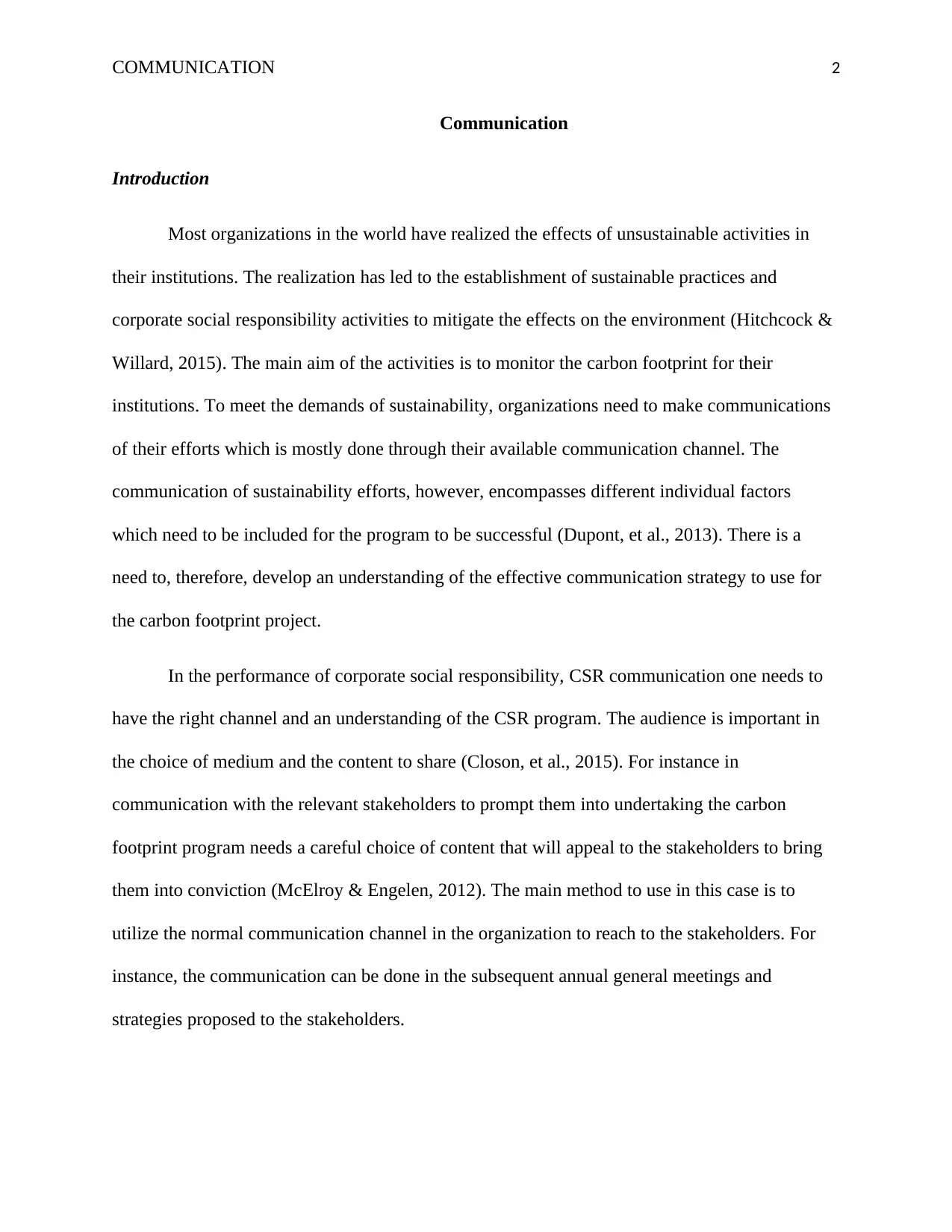
COMMUNICATION 2
Communication
Introduction
Most organizations in the world have realized the effects of unsustainable activities in
their institutions. The realization has led to the establishment of sustainable practices and
corporate social responsibility activities to mitigate the effects on the environment (Hitchcock &
Willard, 2015). The main aim of the activities is to monitor the carbon footprint for their
institutions. To meet the demands of sustainability, organizations need to make communications
of their efforts which is mostly done through their available communication channel. The
communication of sustainability efforts, however, encompasses different individual factors
which need to be included for the program to be successful (Dupont, et al., 2013). There is a
need to, therefore, develop an understanding of the effective communication strategy to use for
the carbon footprint project.
In the performance of corporate social responsibility, CSR communication one needs to
have the right channel and an understanding of the CSR program. The audience is important in
the choice of medium and the content to share (Closon, et al., 2015). For instance in
communication with the relevant stakeholders to prompt them into undertaking the carbon
footprint program needs a careful choice of content that will appeal to the stakeholders to bring
them into conviction (McElroy & Engelen, 2012). The main method to use in this case is to
utilize the normal communication channel in the organization to reach to the stakeholders. For
instance, the communication can be done in the subsequent annual general meetings and
strategies proposed to the stakeholders.
Communication
Introduction
Most organizations in the world have realized the effects of unsustainable activities in
their institutions. The realization has led to the establishment of sustainable practices and
corporate social responsibility activities to mitigate the effects on the environment (Hitchcock &
Willard, 2015). The main aim of the activities is to monitor the carbon footprint for their
institutions. To meet the demands of sustainability, organizations need to make communications
of their efforts which is mostly done through their available communication channel. The
communication of sustainability efforts, however, encompasses different individual factors
which need to be included for the program to be successful (Dupont, et al., 2013). There is a
need to, therefore, develop an understanding of the effective communication strategy to use for
the carbon footprint project.
In the performance of corporate social responsibility, CSR communication one needs to
have the right channel and an understanding of the CSR program. The audience is important in
the choice of medium and the content to share (Closon, et al., 2015). For instance in
communication with the relevant stakeholders to prompt them into undertaking the carbon
footprint program needs a careful choice of content that will appeal to the stakeholders to bring
them into conviction (McElroy & Engelen, 2012). The main method to use in this case is to
utilize the normal communication channel in the organization to reach to the stakeholders. For
instance, the communication can be done in the subsequent annual general meetings and
strategies proposed to the stakeholders.
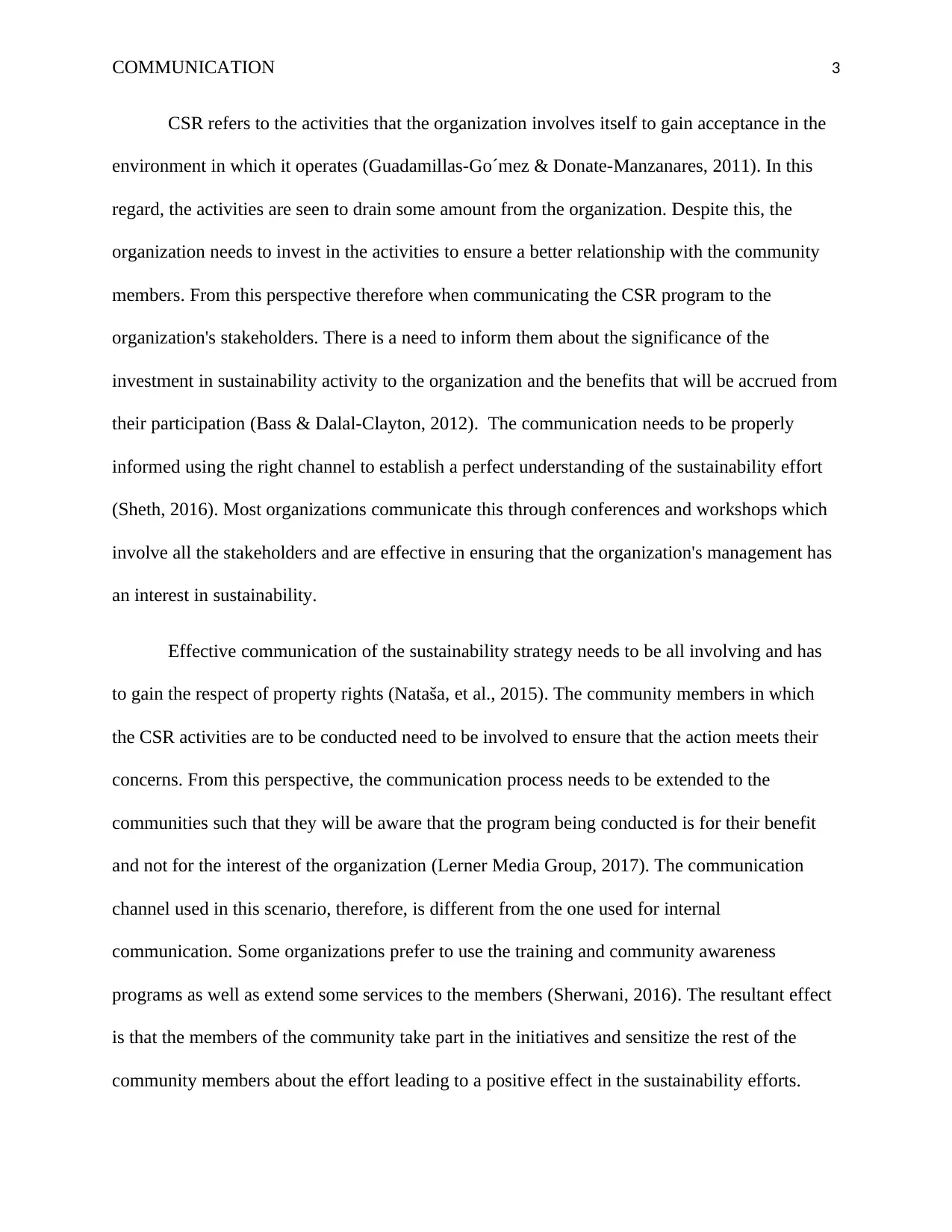
COMMUNICATION 3
CSR refers to the activities that the organization involves itself to gain acceptance in the
environment in which it operates (Guadamillas-Go´mez & Donate-Manzanares, 2011). In this
regard, the activities are seen to drain some amount from the organization. Despite this, the
organization needs to invest in the activities to ensure a better relationship with the community
members. From this perspective therefore when communicating the CSR program to the
organization's stakeholders. There is a need to inform them about the significance of the
investment in sustainability activity to the organization and the benefits that will be accrued from
their participation (Bass & Dalal-Clayton, 2012). The communication needs to be properly
informed using the right channel to establish a perfect understanding of the sustainability effort
(Sheth, 2016). Most organizations communicate this through conferences and workshops which
involve all the stakeholders and are effective in ensuring that the organization's management has
an interest in sustainability.
Effective communication of the sustainability strategy needs to be all involving and has
to gain the respect of property rights (Nataša, et al., 2015) . The community members in which
the CSR activities are to be conducted need to be involved to ensure that the action meets their
concerns. From this perspective, the communication process needs to be extended to the
communities such that they will be aware that the program being conducted is for their benefit
and not for the interest of the organization (Lerner Media Group, 2017). The communication
channel used in this scenario, therefore, is different from the one used for internal
communication. Some organizations prefer to use the training and community awareness
programs as well as extend some services to the members (Sherwani, 2016). The resultant effect
is that the members of the community take part in the initiatives and sensitize the rest of the
community members about the effort leading to a positive effect in the sustainability efforts.
CSR refers to the activities that the organization involves itself to gain acceptance in the
environment in which it operates (Guadamillas-Go´mez & Donate-Manzanares, 2011). In this
regard, the activities are seen to drain some amount from the organization. Despite this, the
organization needs to invest in the activities to ensure a better relationship with the community
members. From this perspective therefore when communicating the CSR program to the
organization's stakeholders. There is a need to inform them about the significance of the
investment in sustainability activity to the organization and the benefits that will be accrued from
their participation (Bass & Dalal-Clayton, 2012). The communication needs to be properly
informed using the right channel to establish a perfect understanding of the sustainability effort
(Sheth, 2016). Most organizations communicate this through conferences and workshops which
involve all the stakeholders and are effective in ensuring that the organization's management has
an interest in sustainability.
Effective communication of the sustainability strategy needs to be all involving and has
to gain the respect of property rights (Nataša, et al., 2015) . The community members in which
the CSR activities are to be conducted need to be involved to ensure that the action meets their
concerns. From this perspective, the communication process needs to be extended to the
communities such that they will be aware that the program being conducted is for their benefit
and not for the interest of the organization (Lerner Media Group, 2017). The communication
channel used in this scenario, therefore, is different from the one used for internal
communication. Some organizations prefer to use the training and community awareness
programs as well as extend some services to the members (Sherwani, 2016). The resultant effect
is that the members of the community take part in the initiatives and sensitize the rest of the
community members about the effort leading to a positive effect in the sustainability efforts.
⊘ This is a preview!⊘
Do you want full access?
Subscribe today to unlock all pages.

Trusted by 1+ million students worldwide
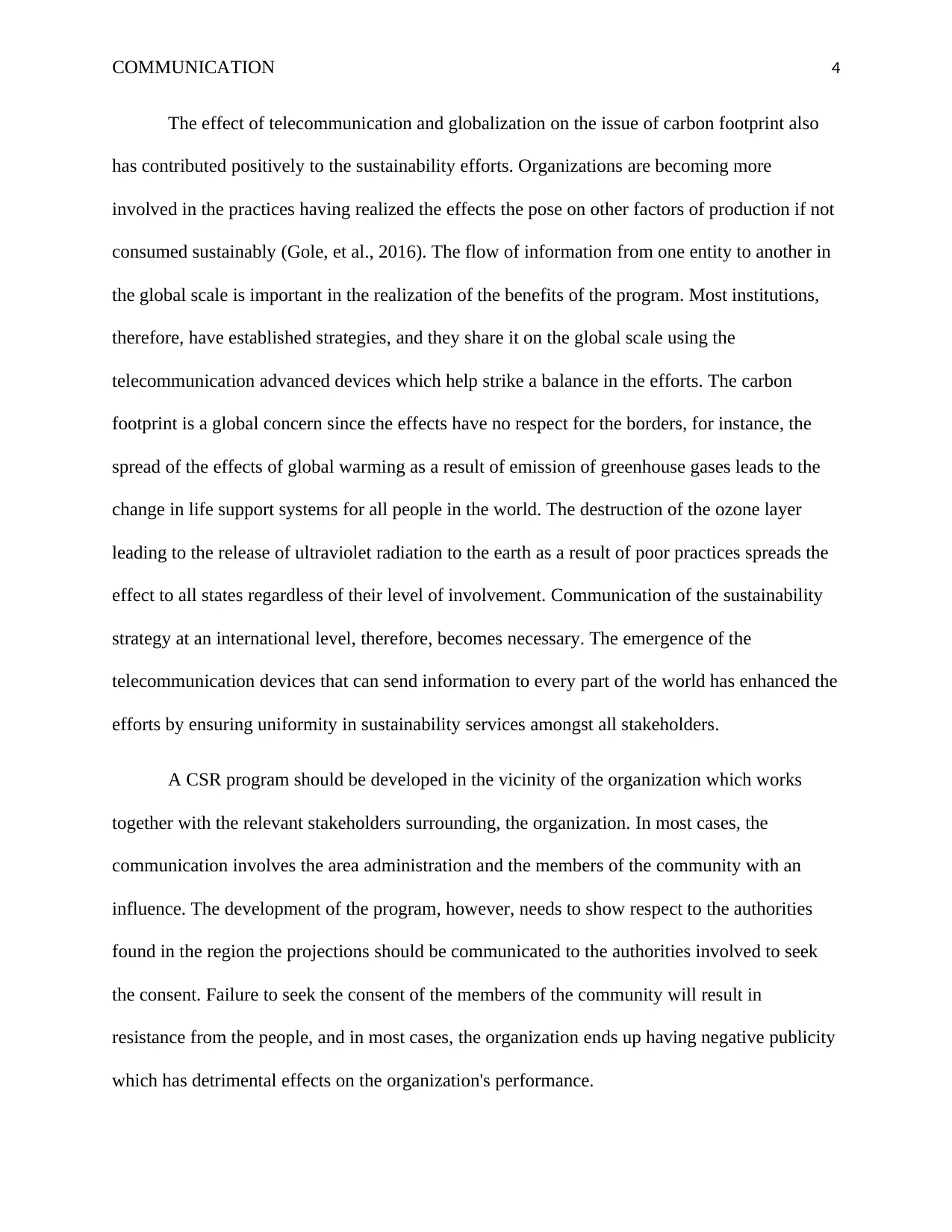
COMMUNICATION 4
The effect of telecommunication and globalization on the issue of carbon footprint also
has contributed positively to the sustainability efforts. Organizations are becoming more
involved in the practices having realized the effects the pose on other factors of production if not
consumed sustainably (Gole, et al., 2016). The flow of information from one entity to another in
the global scale is important in the realization of the benefits of the program. Most institutions,
therefore, have established strategies, and they share it on the global scale using the
telecommunication advanced devices which help strike a balance in the efforts. The carbon
footprint is a global concern since the effects have no respect for the borders, for instance, the
spread of the effects of global warming as a result of emission of greenhouse gases leads to the
change in life support systems for all people in the world. The destruction of the ozone layer
leading to the release of ultraviolet radiation to the earth as a result of poor practices spreads the
effect to all states regardless of their level of involvement. Communication of the sustainability
strategy at an international level, therefore, becomes necessary. The emergence of the
telecommunication devices that can send information to every part of the world has enhanced the
efforts by ensuring uniformity in sustainability services amongst all stakeholders.
A CSR program should be developed in the vicinity of the organization which works
together with the relevant stakeholders surrounding, the organization. In most cases, the
communication involves the area administration and the members of the community with an
influence. The development of the program, however, needs to show respect to the authorities
found in the region the projections should be communicated to the authorities involved to seek
the consent. Failure to seek the consent of the members of the community will result in
resistance from the people, and in most cases, the organization ends up having negative publicity
which has detrimental effects on the organization's performance.
The effect of telecommunication and globalization on the issue of carbon footprint also
has contributed positively to the sustainability efforts. Organizations are becoming more
involved in the practices having realized the effects the pose on other factors of production if not
consumed sustainably (Gole, et al., 2016). The flow of information from one entity to another in
the global scale is important in the realization of the benefits of the program. Most institutions,
therefore, have established strategies, and they share it on the global scale using the
telecommunication advanced devices which help strike a balance in the efforts. The carbon
footprint is a global concern since the effects have no respect for the borders, for instance, the
spread of the effects of global warming as a result of emission of greenhouse gases leads to the
change in life support systems for all people in the world. The destruction of the ozone layer
leading to the release of ultraviolet radiation to the earth as a result of poor practices spreads the
effect to all states regardless of their level of involvement. Communication of the sustainability
strategy at an international level, therefore, becomes necessary. The emergence of the
telecommunication devices that can send information to every part of the world has enhanced the
efforts by ensuring uniformity in sustainability services amongst all stakeholders.
A CSR program should be developed in the vicinity of the organization which works
together with the relevant stakeholders surrounding, the organization. In most cases, the
communication involves the area administration and the members of the community with an
influence. The development of the program, however, needs to show respect to the authorities
found in the region the projections should be communicated to the authorities involved to seek
the consent. Failure to seek the consent of the members of the community will result in
resistance from the people, and in most cases, the organization ends up having negative publicity
which has detrimental effects on the organization's performance.
Paraphrase This Document
Need a fresh take? Get an instant paraphrase of this document with our AI Paraphraser
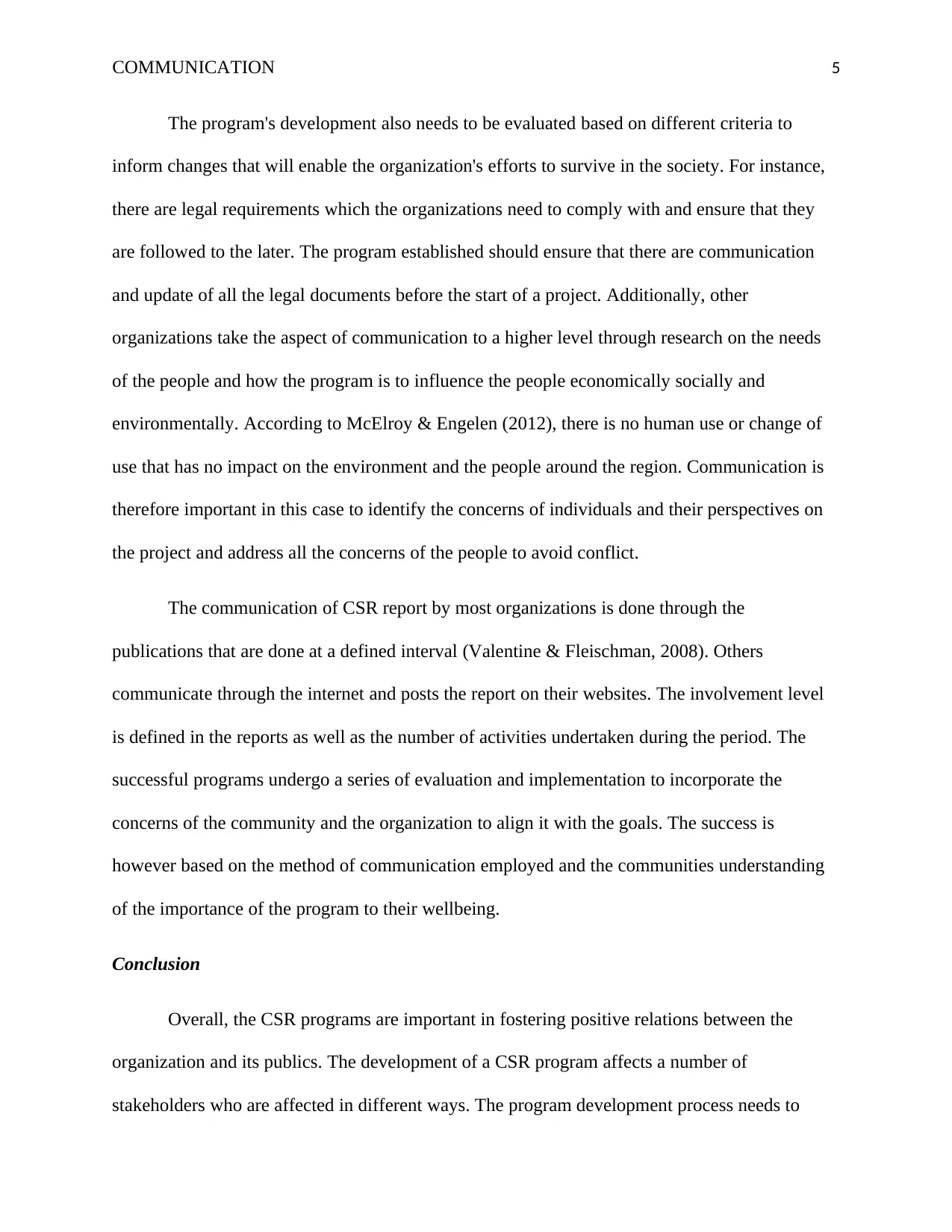
COMMUNICATION 5
The program's development also needs to be evaluated based on different criteria to
inform changes that will enable the organization's efforts to survive in the society. For instance,
there are legal requirements which the organizations need to comply with and ensure that they
are followed to the later. The program established should ensure that there are communication
and update of all the legal documents before the start of a project. Additionally, other
organizations take the aspect of communication to a higher level through research on the needs
of the people and how the program is to influence the people economically socially and
environmentally. According to McElroy & Engelen (2012), there is no human use or change of
use that has no impact on the environment and the people around the region. Communication is
therefore important in this case to identify the concerns of individuals and their perspectives on
the project and address all the concerns of the people to avoid conflict.
The communication of CSR report by most organizations is done through the
publications that are done at a defined interval (Valentine & Fleischman, 2008). Others
communicate through the internet and posts the report on their websites. The involvement level
is defined in the reports as well as the number of activities undertaken during the period. The
successful programs undergo a series of evaluation and implementation to incorporate the
concerns of the community and the organization to align it with the goals. The success is
however based on the method of communication employed and the communities understanding
of the importance of the program to their wellbeing.
Conclusion
Overall, the CSR programs are important in fostering positive relations between the
organization and its publics. The development of a CSR program affects a number of
stakeholders who are affected in different ways. The program development process needs to
The program's development also needs to be evaluated based on different criteria to
inform changes that will enable the organization's efforts to survive in the society. For instance,
there are legal requirements which the organizations need to comply with and ensure that they
are followed to the later. The program established should ensure that there are communication
and update of all the legal documents before the start of a project. Additionally, other
organizations take the aspect of communication to a higher level through research on the needs
of the people and how the program is to influence the people economically socially and
environmentally. According to McElroy & Engelen (2012), there is no human use or change of
use that has no impact on the environment and the people around the region. Communication is
therefore important in this case to identify the concerns of individuals and their perspectives on
the project and address all the concerns of the people to avoid conflict.
The communication of CSR report by most organizations is done through the
publications that are done at a defined interval (Valentine & Fleischman, 2008). Others
communicate through the internet and posts the report on their websites. The involvement level
is defined in the reports as well as the number of activities undertaken during the period. The
successful programs undergo a series of evaluation and implementation to incorporate the
concerns of the community and the organization to align it with the goals. The success is
however based on the method of communication employed and the communities understanding
of the importance of the program to their wellbeing.
Conclusion
Overall, the CSR programs are important in fostering positive relations between the
organization and its publics. The development of a CSR program affects a number of
stakeholders who are affected in different ways. The program development process needs to
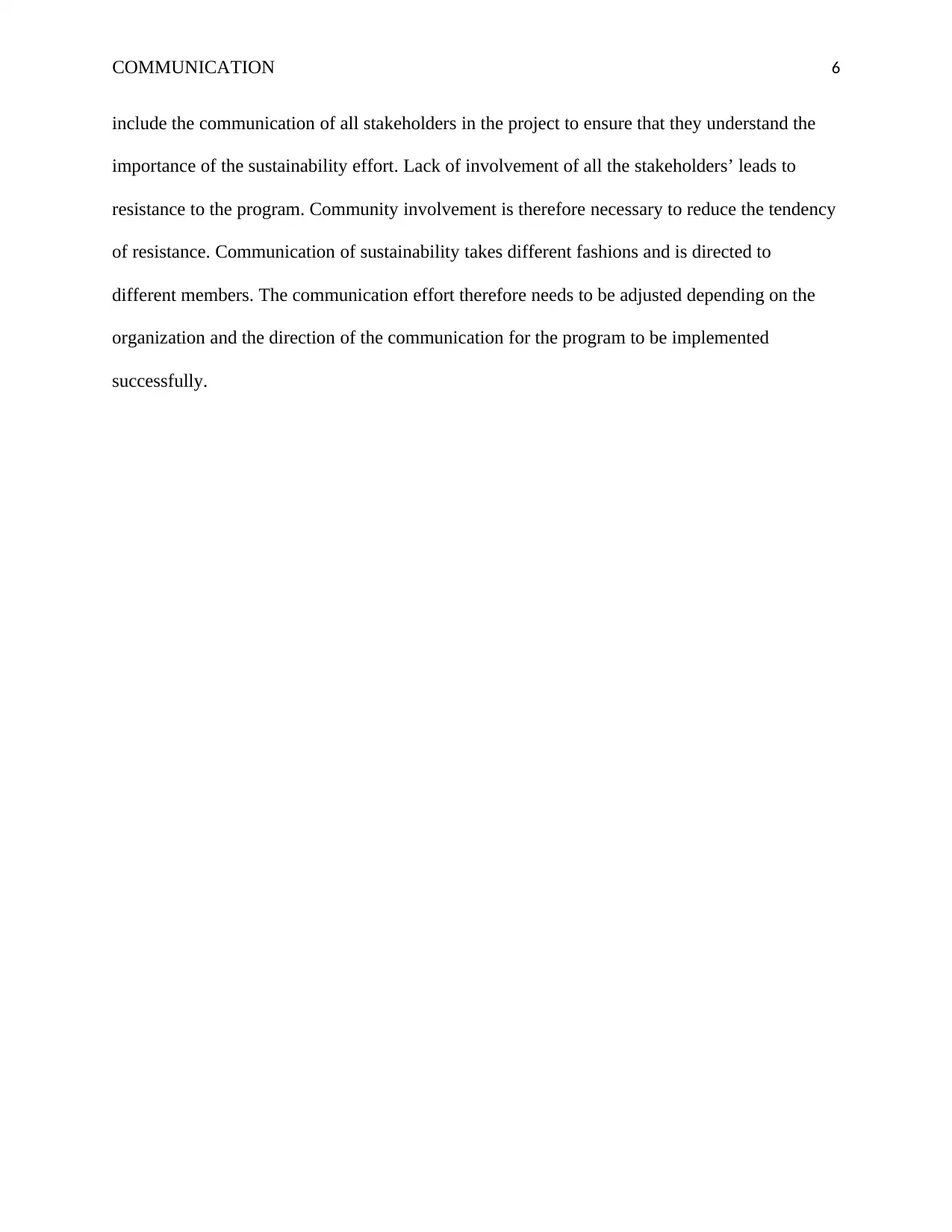
COMMUNICATION 6
include the communication of all stakeholders in the project to ensure that they understand the
importance of the sustainability effort. Lack of involvement of all the stakeholders’ leads to
resistance to the program. Community involvement is therefore necessary to reduce the tendency
of resistance. Communication of sustainability takes different fashions and is directed to
different members. The communication effort therefore needs to be adjusted depending on the
organization and the direction of the communication for the program to be implemented
successfully.
include the communication of all stakeholders in the project to ensure that they understand the
importance of the sustainability effort. Lack of involvement of all the stakeholders’ leads to
resistance to the program. Community involvement is therefore necessary to reduce the tendency
of resistance. Communication of sustainability takes different fashions and is directed to
different members. The communication effort therefore needs to be adjusted depending on the
organization and the direction of the communication for the program to be implemented
successfully.
⊘ This is a preview!⊘
Do you want full access?
Subscribe today to unlock all pages.

Trusted by 1+ million students worldwide
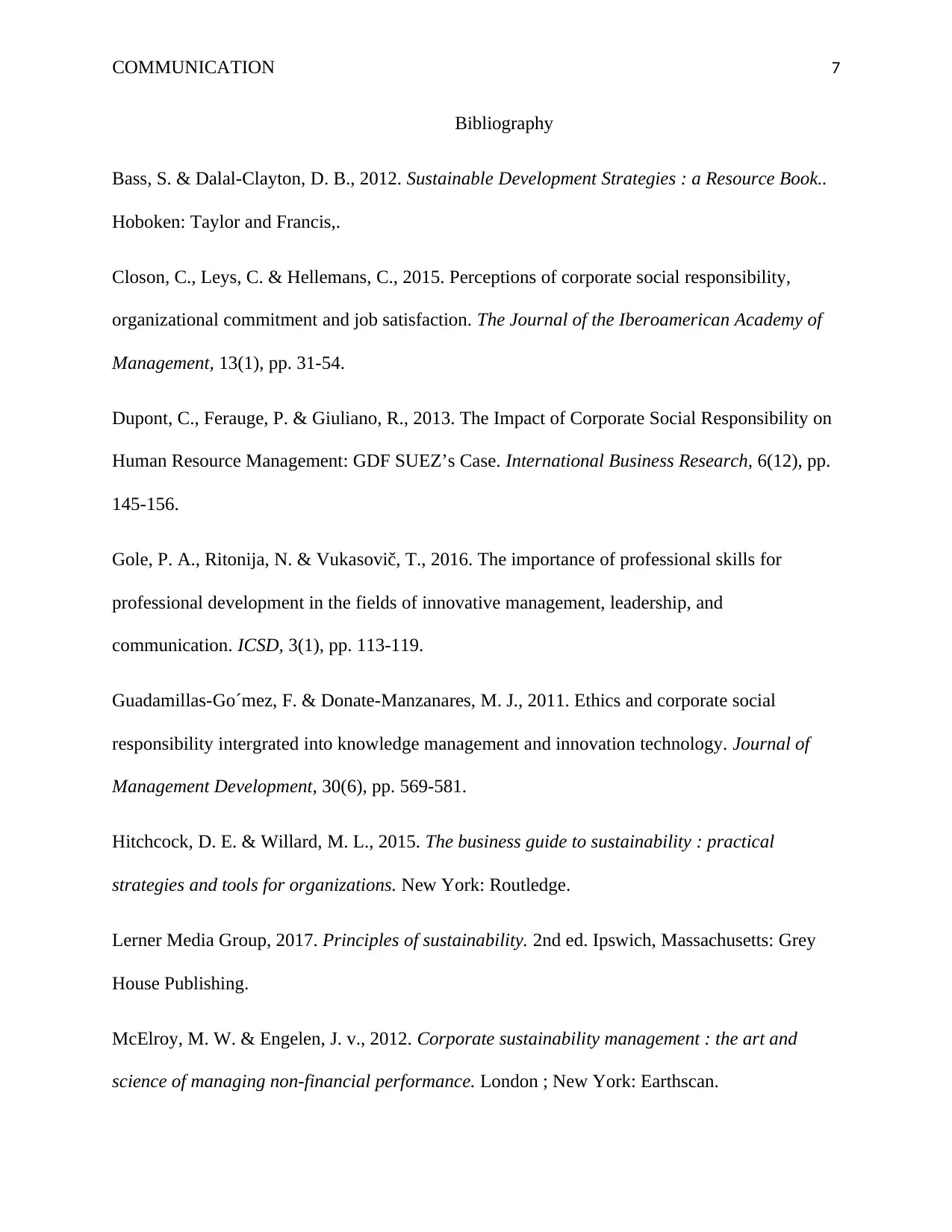
COMMUNICATION 7
Bibliography
Bass, S. & Dalal-Clayton, D. B., 2012. Sustainable Development Strategies : a Resource Book..
Hoboken: Taylor and Francis,.
Closon, C., Leys, C. & Hellemans, C., 2015. Perceptions of corporate social responsibility,
organizational commitment and job satisfaction. The Journal of the Iberoamerican Academy of
Management, 13(1), pp. 31-54.
Dupont, C., Ferauge, P. & Giuliano, R., 2013. The Impact of Corporate Social Responsibility on
Human Resource Management: GDF SUEZ’s Case. International Business Research, 6(12), pp.
145-156.
Gole, P. A., Ritonija, N. & Vukasovič, T., 2016. The importance of professional skills for
professional development in the fields of innovative management, leadership, and
communication. ICSD, 3(1), pp. 113-119.
Guadamillas-Go´mez, F. & Donate-Manzanares, M. J., 2011. Ethics and corporate social
responsibility intergrated into knowledge management and innovation technology. Journal of
Management Development, 30(6), pp. 569-581.
Hitchcock, D. E. & Willard, M. L., 2015. The business guide to sustainability : practical
strategies and tools for organizations. New York: Routledge.
Lerner Media Group, 2017. Principles of sustainability. 2nd ed. Ipswich, Massachusetts: Grey
House Publishing.
McElroy, M. W. & Engelen, J. v., 2012. Corporate sustainability management : the art and
science of managing non-financial performance. London ; New York: Earthscan.
Bibliography
Bass, S. & Dalal-Clayton, D. B., 2012. Sustainable Development Strategies : a Resource Book..
Hoboken: Taylor and Francis,.
Closon, C., Leys, C. & Hellemans, C., 2015. Perceptions of corporate social responsibility,
organizational commitment and job satisfaction. The Journal of the Iberoamerican Academy of
Management, 13(1), pp. 31-54.
Dupont, C., Ferauge, P. & Giuliano, R., 2013. The Impact of Corporate Social Responsibility on
Human Resource Management: GDF SUEZ’s Case. International Business Research, 6(12), pp.
145-156.
Gole, P. A., Ritonija, N. & Vukasovič, T., 2016. The importance of professional skills for
professional development in the fields of innovative management, leadership, and
communication. ICSD, 3(1), pp. 113-119.
Guadamillas-Go´mez, F. & Donate-Manzanares, M. J., 2011. Ethics and corporate social
responsibility intergrated into knowledge management and innovation technology. Journal of
Management Development, 30(6), pp. 569-581.
Hitchcock, D. E. & Willard, M. L., 2015. The business guide to sustainability : practical
strategies and tools for organizations. New York: Routledge.
Lerner Media Group, 2017. Principles of sustainability. 2nd ed. Ipswich, Massachusetts: Grey
House Publishing.
McElroy, M. W. & Engelen, J. v., 2012. Corporate sustainability management : the art and
science of managing non-financial performance. London ; New York: Earthscan.
Paraphrase This Document
Need a fresh take? Get an instant paraphrase of this document with our AI Paraphraser
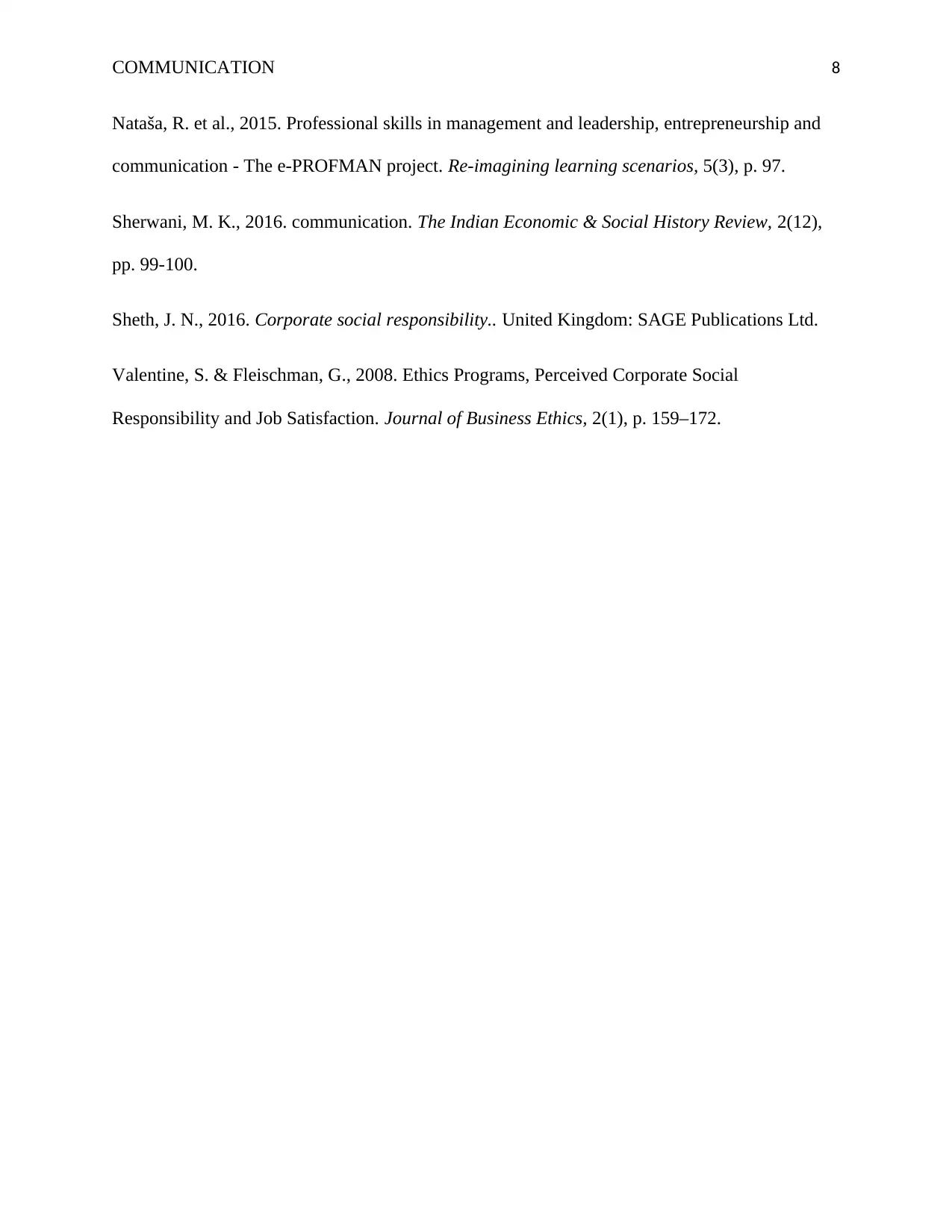
COMMUNICATION 8
Nataša, R. et al., 2015. Professional skills in management and leadership, entrepreneurship and
communication - The e-PROFMAN project. Re-imagining learning scenarios, 5(3), p. 97.
Sherwani, M. K., 2016. communication. The Indian Economic & Social History Review, 2(12),
pp. 99-100.
Sheth, J. N., 2016. Corporate social responsibility.. United Kingdom: SAGE Publications Ltd.
Valentine, S. & Fleischman, G., 2008. Ethics Programs, Perceived Corporate Social
Responsibility and Job Satisfaction. Journal of Business Ethics, 2(1), p. 159–172.
Nataša, R. et al., 2015. Professional skills in management and leadership, entrepreneurship and
communication - The e-PROFMAN project. Re-imagining learning scenarios, 5(3), p. 97.
Sherwani, M. K., 2016. communication. The Indian Economic & Social History Review, 2(12),
pp. 99-100.
Sheth, J. N., 2016. Corporate social responsibility.. United Kingdom: SAGE Publications Ltd.
Valentine, S. & Fleischman, G., 2008. Ethics Programs, Perceived Corporate Social
Responsibility and Job Satisfaction. Journal of Business Ethics, 2(1), p. 159–172.
1 out of 8
Related Documents
Your All-in-One AI-Powered Toolkit for Academic Success.
+13062052269
info@desklib.com
Available 24*7 on WhatsApp / Email
![[object Object]](/_next/static/media/star-bottom.7253800d.svg)
Unlock your academic potential
Copyright © 2020–2025 A2Z Services. All Rights Reserved. Developed and managed by ZUCOL.





